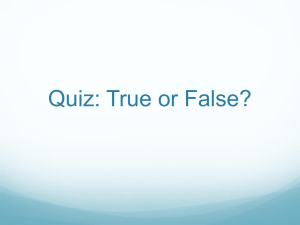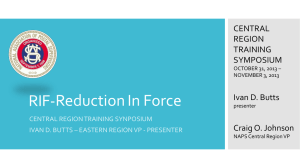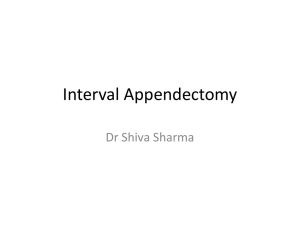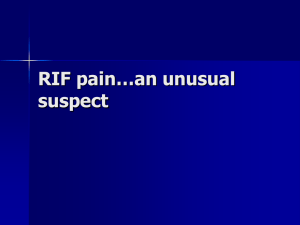08_SW-RIF - Teaching-WIKI
advertisement
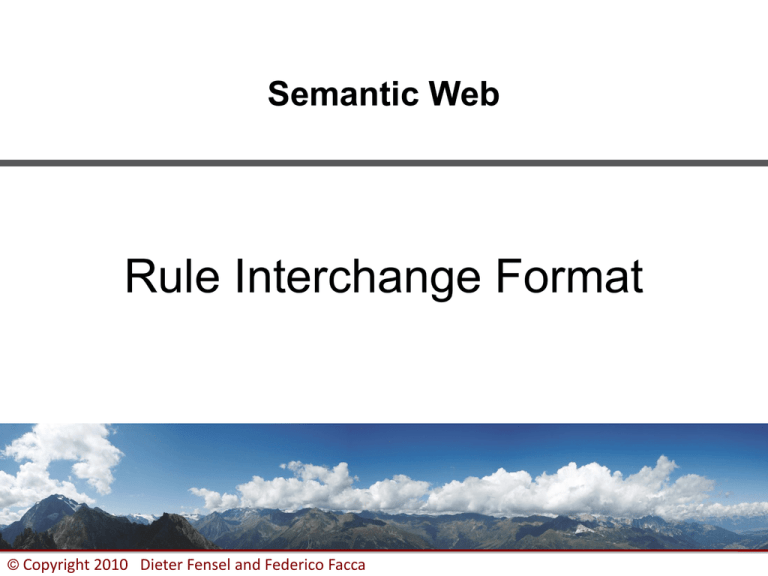
Semantic Web
Rule Interchange Format
© Copyright 2010 Dieter Fensel and Federico Facca
1
Where are we?
#
Title
1
Introduction
2
Semantic Web Architecture
3
Resource Description Framework (RDF)
4
Web of data
5
Generating Semantic Annotations
6
Storage and Querying
7
Web Ontology Language (OWL)
8
Rule Interchange Format (RIF)
9
Reasoning on the Web
10
Ontologies
11
Social Semantic Web
12
Semantic Web Services
13
Tools
14
Applications
2
Agenda
1.
2.
Introduction and Motivation
Technical Solution
1.
2.
3.
4.
5.
3.
4.
5.
6.
Principles
Dialects
Syntax
Semantic
Tools
Illustration by an example
Extensions
Summary
References
3
Semantic Web Stack
Adapted from http://en.wikipedia.org/wiki/Semantic_Web_Stack
4
MOTIVATION
5
Why Rule Exchange?
(and not The One True Rule Language)
•
Many different paradigms for rule languages
–
–
–
–
•
•
•
Pure first-order
Logic programming/deductive databases
Production rules
Reactive rules
Many different features, syntaxes
Different commercial interests
Many egos, different preferences, ...
[Michael Kifer, Rule Interchange Format: The Framework]
6
Why Different Dialects?
(and Not Just One Dialect)
•
Again: many paradigms for rule languages
–
–
–
–
•
Many different semantics
–
–
–
–
•
First-order rules
Logic programming/deductive databases
Reactive rules
Production rules
Classical first-order
Stable-model semantics for negation
Well-founded semantics for negation
... ... ...
A carefully chosen set of interrelated dialects can serve the purpose of
sharing and exchanging rules over the Web
[Michael Kifer, Rule Interchange Format: The Framework]
7
The importance of logic
•
Rules needs a proper formalization
– Disambiguation: a rules should be always be interpreted consistently according its
underlying formal semantics
•
•
Rules need to be expressed in a high level language
Rules are generally structured in the form IF X THEN Y
– Importance of consequence
Logic provides
• High-level language
• Well-understood formal semantics
• Precise notion of logical consequence
• Proof systems
– Automatic derivation of statements from a set of premises
– Sound and complete (Predicate logic)
– More expressive logics (higher-order logics) are not
8
First Order Logic in Short
• “Classical” logic
– Based on propositional logic (Aristotle, ¿300 BC)
– Developed in 19th century (Frege, 1879)
• Semi-decidable logic
– Enumerate all true sentences
– If a sentence is false, the algorithm might not terminate
• FOL is the basis for
– Logic Programming: Horn Logic
– Description Logics: 2-variable fragment
• A logic for describing object, functions and relations
– Objects are “things” in the world: persons, cars, etc.
– Functions take a number of objects as argument and “return” an
object, depending on the arguments: addition, father-of, etc.
– Relations hold between objects: distance, marriage, etc.
– Often, a function can also be modeled as a relation
9
First Order Logic in Short
• Propositional logic deals only with truth-functional validity: any
assignment of truth-values to the variables of the argument should
make either the conclusion true or at least one of the premises false.
– All men are mortal
– Socrates is a man
– Therefore, Socrates is mortal
• which upon translation into propositional logic yields:
– A
– B
– Therefore C
10
First Order Logic in Short
•
According to propositional logic, this translation is invalid.
•
Propositional logic validates arguments according to their structure, and
nothing in the structure of this translated argument (C follows from A and B,
for arbitrary A, B, C) suggests that it is valid.
•
First Order Logic satisfies such needs!
•
Is this enough to apply such logic on the Web? Unfortunately no… FOL is
not decidable and not efficient.
•
Neither families derived from it are ready to scale a the Web size (HL and
DL).
11
Why cannot we use FOL in the SW?
•
FOL is undecidable
•
Reasoning is hard
•
You do not need to use an atomic bomb to kill a mosquito!
•
… we need a simpler logic family!
•
Can we maintain some of the advantages of FOL and achieve
decidability, without stepping back to propositional logic limitations?
•
There are many logic families originated from FOL trying to deal with
such problems
12
Horn Logic 1/3
•
Simpler knowledge representation
– “if ... then ...” rules
•
Efficient reasoning algorithms, e.g.
– Forward chaining
– Backward chaining
– SLDNF resolution
•
Basis for Logic Programming and Deductive Databases
13
Horn Logic 2/3
•
A Horn formula is a disjunction of literals with one positive literal, with all
variables universally quantified:
– () B1 ... Bn H
•
Can be written as an implication:
– () B1 ... Bn H
•
Decidable reasoning
– without function symbols
– limited use of function symbols
•
e.g., no recursion over function symbols
14
Horn Logic 3/3: Algorithms
•
Forward chaining: An inference engine using forward chaining searches
the inference rules until it finds one where the antecedent (If clause) is
known to be true. When found it can conclude, or infer, the consequent
(Then clause), resulting in the addition of new information to its data.
•
Backward chaining: An inference engine using backward chaining
would search the inference rules until it finds one which has a
consequent (Then clause) that matches a desired goal. If the
antecedent (If clause) of that rule is not known to be true, then it is
added to the list of goals (in order for your goal to be confirmed you
must also provide data that confirms this new rule).
•
Selective Linear Definite clause resolution is the basic inference rule
used in logic programming. SLDNF is an extension to deal with
negation as failure.
15
Description Logics 1/2
•
A family of logic based Knowledge Representation formalisms
– Descendants of semantic networks and KL-ONE
– Describe domain in terms of concepts (classes), roles (properties, relationships) and
individuals
•
Distinguished by:
– Formal semantics (typically model theoretic)
•
•
•
Decidable fragments of FOL (often contained in C2)
Closely related to Propositional Modal & Dynamic Logics
Closely related to Guarded Fragment
– Provision of inference services
•
•
Decision procedures for key problems (satisfiability, subsumption, etc)
Implemented systems (highly optimized)
16
Description Logics 2/2
•
Formalization for frame-based knowledge representation
•
Frame = all information about a class
– Superclasses
– Property restrictions
•
Description Logic Knowledge Base
– Terminological Box (TBox)
•
Class definitions
– Assertional Box (ABox)
•
Concrete (instance) data
17
TECHNICAL SOLUTION
18
A rule interchange format to suite all the needs!
PRINCIPLES
19
What is the Rule Interchange Format (RIF)?
•
A set of dialects to enable rule exchange among different rule systems
Rule system 1
semantics
preserving
mapping
RIF dialect X
semantics
preserving
mapping
Rule system 2
20
Rule Interchange Format Goals
•
Exchange of Rules
– The primary goal of RIF is to facilitate the exchange of rules
•
Consistency with W3C specifications
– A W3C specification that builds on and develops the existing range of specifications
that have been developed by the W3C
– Existing W3C technologies should fit well with RIF
•
Wide scale Adoption
– Rules interchange becomes more effective the wider is their adoption ("network
effect“)
21
RIF Requirements 1
•
Compliance model
– Clear conformance criteria, defining what is or is not a conformant to RIF
•
Different semantics
– RIF must cover rule languages having different semantics
•
Limited number of dialects
– RIF must have a standard core and a limited number of standard dialects based upon
that core
•
OWL data
– RIF must cover OWL knowledge bases as data where compatible with RIF semantics
[http://www.w3.org/TR/rif-ucr/]
22
RIF Requirements 2
•
RDF data
– RIF must cover RDF triples as data where compatible with RIF semantics
•
Dialect identification
– The semantics of a RIF document must be uniquely determined by the content of the
document, without out-of-band data
•
XML syntax
– RIF must have an XML syntax as its primary normative syntax
•
Merge rule sets
– RIF must support the ability to merge rule sets
•
Identify rule sets
– RIF must support the identification of rule sets
[http://www.w3.org/TR/rif-ucr/]
23
Basic Principle: a Modular Architecture
• RIF wants to cover: rules in logic dialects and rules used
by production rule systems (e.g. active databases)
• Logic rules only add knowledge
• Production rules change the facts!
• Logic rules + Production Rules?
– Define a logic-based core and a separate production-rule core
– If there is an intersection, define the common core
24
RIF Architecture
Extended syntax
and semantics for
logic rules
“Modules” can be
added to cover new
needs!
RIF-FLD
extends
Syntax and
semantics for
production rules
RIF-PRD
RIF-BLD
extends
extends
Data types
RIF-DTB
uses
Basic syntax and
semantics for
logic rules
RIF-Core
Minimum common
Intersection (syntax)
uses
uses
RIFRDF/OWL
RIF-XML
data
Compatibility and
Import of data
25
Introduction to RIF Dialects
DIALECTS
26
RIF Dialects
•
RIF Core
–
–
•
A language of definite Horn rules without function symbols (~ Datalog)
A language of production rules where conclusions are interpreted as assert actions
RIF BLD
–
A language that lies within the intersection of first-order and logic-programming systems
•
RIF FLD
•
RIF PRD
•
Other common specifications
–
–
–
RIF DTB – Defines data types and builtins supported by RIF
RIF OWL/RDF compatibility – Defines how OWL and RDF can be used within RIF
RIF XML data - Defines how XML can be used within RIF
27
RIF Core
•
The Core dialect of the Rule Interchange Format
•
A subset of RIF-BLD and of RIF-PRD
– a well-formed RIF-Core formula (including document and condition formulas) is also a
well-formed RIF-BLD formula
– a RIF-PRD consumer can treat a RIF-Core document as if it was a RIF-PRD rule set
while it also conforms to the normative RIF-Core first order semantics
– due to the presence of builtin functions and predicates there are rule sets in the
syntactic intersection of RIF-PRD and RIF-BLD which would not terminate under RIFPRD semantics
– not the maximal common subset of RIF-BLD and RIF-PRD
•
Based on built-in functions and predicates over selected XML Schema
datatypes, as specified in RIF-DTB
28
RIF Core
•
Datalog extensions to support
–
–
–
–
•
objects and frames as in F-logic
internationalized resource identifiers (or IRIs) as identifiers for concepts
XML Schema datatypes
RIF RDF and OWL Compatibility defines the syntax and semantics of integrated RIFCore/RDF and RIF-Core/OWL languages
A Web-aware language
– Designed to enable interoperability among rule languages in general, and its uses are
not limited to the Web
29
RIF Core Example
1. A buyer buys an item from a seller if the seller sells the item to the
buyer.
2. John sells LeRif to Mary.
•
The fact Mary buys LeRif from John can be logically derived by a modus
ponens argument.
Document(
Prefix(cpt <http://example.com/concepts#>)
Prefix(ppl <http://example.com/people#>)
Prefix(bks <http://example.com/books#>)
Group (
Forall ?Buyer ?Item ?Seller (
cpt:buy(?Buyer ?Item ?Seller) :- cpt:sell(?Seller ?Item ?Buyer)
)
cpt:sell(ppl:John bks:LeRif ppl:Mary)
)
)
30
RIF BLD
•
The Basic Logic Dialect of the Rule Interchange Format
•
Corresponds to the language of definite Horn rules with equality and a
standard first-order semantics
•
Has a number of extensions to support
–
–
–
–
•
objects and frames as in F-logic
internationalized resource identifiers (or IRIs) as identifiers for concepts
XML Schema datatypes
RIF RDF and OWL Compatibility defines the syntax and semantics of integrated RIFCore/RDF and RIF-Core/OWL languages
RIF-BLD designed to be a simple dialect with limited expressiveness
that lies within the intersection of first-order and logic-programming
systems
– RIF-BLD does not support negation
31
RIF FLD
•
The RIF Framework for Logic Dialects
•
A formalism for specifying all logic dialects of RIF
– RIF BLD, RIF Core (albeit not RIF-PRD, as it is not a logic-based RIF dialect)
•
Syntax and semantics described mechanisms that are commonly used
for various logic languages (but rarely brought all together)
– Required because the framework must be broad enough to accommodate several
different types of logic languages and because various advanced mechanisms are
needed to facilitate translation into a common framework
–
•
The needs of future dialects might stimulate further evolution of RIFFLD
32
RIF PRD
•
The RIF Production Rule Dialect
•
A formalism for specifying production rules
– RIF BLD, RIF Core (albeit not RIF-PRD, as it is not a logic-based RIF dialect)
•
Datalog extensions to support
–
–
–
–
objects and frames as in F-logic
internationalized resource identifiers (or IRIs) as identifiers for concepts
XML Schema datatypes
RIF RDF and OWL Compatibility defines the syntax and semantics of integrated RIFCore/RDF and RIF-Core/OWL languages
33
RIF PRD Example
A customer becomes a "Gold" customer when his cumulative
purchases during the current year reach $5000
Prefix(ex <http://example.com/2008/prd1#>)
Forall ?customer ?purchasesYTD (
If
And(
?customer#ex:Customer
?customer[ex:purchasesYTD->?purchasesYTD]
External(pred:numeric-greaterthan(?purchasesYTD 5000))
)
Then Do( Modify(?customer[ex:status->"Gold"]))
)
34
SYNTAX
35
Syntactic Framework
•
•
•
Defines the mechanisms for specifying the formal presentation syntax
of RIF logic dialects
Presentation syntax is used in RIF to define the semantics of the
dialects and to illustrate the main ideas with examples
Syntax is not intended to be a concrete syntax for the dialects
– the delimiters of the various syntactic components, parenthesizing, precedence of
operators, … are left out
•
Uses XML as its concrete syntax
36
BLD Alphabet
•
•
•
A countably infinite set of constant symbols Const
A countably infinite set of variable symbols Var (disjoint from Const)
A countably infinite set of argument names, ArgNames (disjoint from
Const and Var)
– ArgNames is not supported in RIF-Core
•
•
•
Connective symbols And, Or, and :Quantifiers Exists and Forall
The symbols =, #, ##, ->, External, Import, Prefix, and Base
– ##, the subclass symbol is not supported in RIF-Core
•
•
•
The symbols Group and Document
The symbols for representing lists: List and OpenList
The auxiliary symbols (, ), [, ], <, >, and ^^
37
BLD Terms I
•
Constants and variables
–
•
Positional terms
–
•
If t ∈ Const and t1, ..., tn, n≥0, are base terms then t(t1 ... tn) is a positional term
Terms with named arguments
–
–
•
If t ∈ Const or t ∈ Var then t is a simple term
A term with named arguments is of the form t(s1->v1 ... sn->vn), where n≥0, t ∈ Const and
v1, ..., vn are base terms and s1, ..., sn are pairwise distinct symbols from the set ArgNames
Not valid in RIF-Core
List terms
–
–
–
–
There are two kinds of list terms: open and closed
A closed list has the form List(t1 ... tm), where m≥0 and t1, ..., tm are terms
An open list (or a list with a tail) has the form OpenList(t1 ... tm t), where m>0 and t1, ..., tm, t
are terms
In RIF-Core there are only closed ground lists. A closed ground list is a closed list where t1,
..., tm are ground terms (no tail and no variables are allowed)
38
BLD Terms II
•
Equality terms
–
•
Class membership terms (or just membership terms)
–
•
t##s is a subclass term if t and s are base terms
Not valid in RIF-Core
Frame terms
–
•
t#s is a membership term if t and s are base terms
Subclass terms
–
–
•
t = s is an equality term, if t and s are base terms
t[p1->v1 ... pn->vn] is a frame term (or simply a frame) if t, p1, ..., pn, v1, ..., vn, n ≥ 0, are base
terms
Externally defined terms
–
If t is a positional or a named-argument term then External(t) is an externally defined term
39
BLD Terms Example I
•
Positional term
– "http://example.com/ex1"^^rif:iri(1 "http://example.com/ex2"^^rif:iri(?X 5) "abc")
•
Term with named arguments
– "http://example.com/Person"^^rif:iri(id->"http://example.com/John"^^rif:iri
"age"^^rif:local->?X "spouse"^^rif:local->?Y)
•
Frame term
– "http://example.com/John"^^rif:iri["age"^^rif:local->?X "spouse"^^rif:local->?Y]
•
Empty list
– List()
•
Closed list with variable inside
– List("a"^^xs:string ?Y "c"^^xs:string)
40
BLD Terms Example II
•
Open list with variables
– List("a"^^xs:string ?Y "c"^^xs:string | ?Z)
•
Equality term with lists inside
– List(Head | Tail) = List("a"^^xs:string ?Y "c"^^xs:string)
•
Nested list
– List("a"^^xs:string List(?X "b"^^xs:string) "c"^^xs:string)
•
Membership
– ?X # ?Y
•
Subclass
– ?X ## "http://example.com/ex1"^^rif:iri(?Y)
41
FLD Alphabet (as extension of BLD Alphabet)
•
Connective symbols, which includes Naf, Neg, and NEWCONNECTIVE
– NEWCONNECTIVE is a RIF-FLD extension point
•
A countably infinite set of quantifiers including the extension point,
NEWQUANTIFIER
•
The symbols Dialect, Import, and Module
•
A countable set of aggregate symbols
– RIF-FLD reserves the following symbols for standard aggregate functions: Min, Max,
Count, Avg, Sum, Prod, Set, and Bag (and NEWAGGRFUNC)
•
Auxiliary symbols {, }, |, ?, @, and an extension point NEWSYMBOL
42
FLD Terms (as extension of BLD Alphabet)
•
Formula term
– If S is a connective or a quantifier symbol and t 1, ..., tn are terms then S(t1 ... tn) is a
formula term
•
Aggregate term
– An aggregate term has the form sym ?V[?X1 ... ?Xn](τ), where sym ?V[?X1 ... ?Xn] is an
aggregate symbol, n≥0, and τ is a term
•
Remote term reference
– A remote term reference (also called remote term) is a term of the form φ@r where φ
is a term; r can be a constant, variable, a positional, or a named-argument term.
Remote terms are used to query remote RIF documents, called remote modules
•
NEWTERM
– This is not a specific kind of term, but an extension point.
43
FLD Terms Example
•
Formula terms
– :-("p"^^rif:local(?X) ?X("q"^^xs:string)) (usually written as "p"^^rif:local(?X) :?X("q"^^xs:string))
– Forall?X,?Y(Exists?Z("p"^^rif:local(?X ?Y ?Z))) (usually written as Forall ?X ?Y (Exists ?Z
("p"^^rif:local(?X ?Y ?Z)))
– Or("http://example.com/to-be"^^rif:iri(?X) Neg("http://example.com/to-be"^^rif:iri(?X)))
•
Aggregate term
– avg{?Sal [?Dept]|Exists ?Empl
"http://example.com/salary"^^rif:local(?Empl ?Dept ?Sal)}
•
Remote term
– ?O[?N -> "John"^^rif:string "http://example.com/salary"^^rif:iri > ?S]@"http://acme.foo"^^xs:anyURI
44
PRD Alphabet
•
•
•
A countably infinite set of constant symbols Const,
A countably infinite set of variable symbols Var (disjoint from Const),
Syntactic constructs to denote:
–
–
–
–
–
lists,
function calls,
relations, including equality, class membership and subclass relations
conjunction, disjunction and negation,
and existential conditions.
45
PRD Terms
•
Constants and variables
– If t ∈ Const or t ∈ Var then t is a simple term
•
List terms
– A list has the form List(t1 ... tm), where m≥0 and t1, ..., tm are ground terms, i.e. without
variables. A list of the form List() (i.e., a list in which m=0) is called the empty list
•
Positional terms
– If t ∈ Const and t1, ..., tn, n≥0, are base terms then t(t1 ... tn) is a positional term
46
PRD Terms I (Atomic Formulas)
•
Positional atomic formulas
– If t ∈ Const and t1, ..., tn, n≥0, are terms then t(t1 ... tn) is a positional atomic formula
(or simply an atom)
•
Equality atomic formulas
– t = s is an equality atomic formula (or simply an equality), if t and s are terms
•
Class membership atomic formulas
– t#s is a membership atomic formula (or simply membership) if t and s are terms.
The term t is the object and the term s is the class
47
PRD Terms II (Atomic Formulas)
•
Subclass atomic formulas
– t##s is a subclass atomic formula (or simply a subclass) if t and s are terms
•
Frame atomic formulas
– t[p1->v1 ... pn->vn] is a frame atomic formula (or simply a frame) if t, p1, ..., pn, v1, ...,
vn, n ≥ 0, are terms
•
Externally defined atomic formulas
– If t is a positional atomic formula then External(t) is an externally defined atomic
formula.
48
PRD Terms II (Atomic Formulas)
•
Subclass atomic formulas
– t##s is a subclass atomic formula (or simply a subclass) if t and s are terms
•
Frame atomic formulas
– t[p1->v1 ... pn->vn] is a frame atomic formula (or simply a frame) if t, p1, ..., pn, v1, ...,
vn, n ≥ 0, are terms
•
Externally defined atomic formulas
– If t is a positional atomic formula then External(t) is an externally defined atomic
formula.
49
PRD Terms III (Condition Formulas)
•
Atomic formula
– If φ is an atomic formula then it is also a condition formula
•
Conjunction
– If φ1, ..., φn, n ≥ 0, are condition formulas then so is And(φ1 ... φn), called a conjunctive
formula
– As a special case, And() is allowed and is treated as a tautology, i.e., a formula that is
always true
•
Disjunction
– If φ1, ..., φn, n ≥ 0, are condition formulas then so is Or(φ1 ... φn), called a disjunctive
formula
– As a special case, Or() is permitted and is treated as a contradiction, i.e., a formula
that is always false
50
PRD Terms IV (Condition Formulas)
•
Negation
– If φ is a condition formula, then so is Not(φ), called a negative formula
•
Existentials
– If φ is a condition formula and ?V1, ..., ?Vn, n>0, are variables then Exists ?V1
... ?Vn(φ) is an existential formula
51
PRD Terms V (Atomic Actions)
•
Assert
–
•
Retract
–
•
If t is a term in the RIF-PRD condition language, then Retract(t) is an atomic action
Modify
–
•
If φ is a positional atom or a frame in the RIF-PRD condition language, then Retract(φ) is an
atomic action
Retract object
–
•
If φ is a positional atom, a frame or a membership atomic formula in the RIF-PRD condition
language, then Assert(φ) is an atomic action. φ is called the target of the action
if φ is a frame in the RIF-PRD condition language, then Modify(φ) is an atomic action
Execute
–
if φ is a positional atom in the RIF-PRD condition language, then Execute(φ) is an atomic
action
52
PRD Terms VI (Atomic Blocks)
•
Action variable declaration
– An action variable declaration is a pair, (v p) made of an action variable, v, and an
action variable binding (or, simply, binding), p, where p has one of two forms: frame
object declaration and frame slot value
– frame object declaration: if the action variable, v, is to be assigned the identifier of a
new frame, then the action variable binding is a frame object declaration: New()
– frame slot value: if the action variable, v, is to be assigned the value of a slot of a
ground frame, then the action variable binding is a frame: p = o[s->v], where o is a
term that represents the identifier of the ground frame and s is a term that represents
the name of the slot
•
Action block
– If (v1 p1), ..., (vn pn), n ≥ 0, are action variable declarations, and if a 1, ..., am, m ≥ 1, are
atomic actions, then Do((v1 p1) ... (vn pn) a1 ... am) denotes an action block
53
XML Serialization Framework
•
Defines
– a normative mapping from the RIF-FLD presentation syntax to XML
– and a normative XML Schema for the XML syntax
•
Any conformant XML document for a logic RIF dialect must also be a
conformant XML document for RIF-FLD
– i.e. each mapping for a logic RIF dialect must be a restriction of the corresponding
mapping for RIF-FLD.
– e.g. the mapping from the presentation syntax of RIF-BLD to XML in RIF-BLD is a
restriction of the presentation-syntax-to-XML mapping for RIF-FLD.
54
XML Syntax
And (Exists ?Buyer (cpt:purchase(?Buyer ?Seller
cpt:book(?Author bks:LeRif)
curr:USD(49)))
?Seller=?Author )
<And><formula><Exists><declare><Var>Buyer</Var></declare>
<formula><Atom><op><Const type="&rif;iri">&cpt;purchase</Const></op>
<args ordered="yes"><Var>Buyer</Var> <Var>Seller</Var>
<Expr><op><Const type="&rif;iri">&cpt;book</Const></op>
<args ordered="yes">
<Var>Author</Var>
<Const type="&rif;iri">&bks;LeRif</Const></args>
</Expr>
<Expr><op><Const type="&rif;iri">&curr;USD</Const></op>
<args ordered="yes">
<Const type="&xsd;integer">49</Const></args>
</Expr>
</args>
</Atom></formula>
</Exists></formula>
<formula><Equal>
<side><Var>Seller</Var></side>
<side><Var>Author</Var></side>
</Equal></formula>
</And>
55
SEMANTICS
56
RIF Dialects and Semantics
Semantics of a dialect is derived from these notions by specializing:
•
The effect of the syntax
•
Truth values
•
Data types
•
Logical entailment
57
BLD Semantics
•
The effect of the syntax
– RIF-BLD does not support negation
•
Truth values
– The set TV of truth values in RIF-BLD consists of just two values, t and f such that f <t
t. Clearly, <t is a total order here.
•
Data types
–
–
–
–
–
–
–
–
xsd:long
xsd:integer
xsd:decimal
xsd:string
xsd:time
xsd:dateTime
rdf:XMLLiteral
rif:text
58
BLD Semantics
•
Logical entailment
– Logical entailment in RIF is defined with respect to an unspecified set of intended
semantic structures and that dialects of RIF must make this notion concrete. For RIFBLD, this set is defined in one of the two following equivalent ways:
•
•
as a set of all models
as the unique minimal model
– These two definitions are equivalent for entailment of RIF-BLD conditions by RIF-BLD
rulesets, since all rules in RIF-BLD are Horn
59
BLD Semantic Structures
•
A semantic structure, I, is a tuple of the form:
<TV, DTS, D, IC, IV, IF, Iframe, ISF, Isub, Iisa, I=, ITruth>
–
–
–
–
–
–
–
–
–
–
–
–
–
D is a non-empty set of elements called the domain of I
TV denotes the set of truth values that the semantic structure uses
DTS is the set of primitive data types used in I
IC maps constants to elements of D
IV maps variables to elements of Dind.
IF maps D to functions D* → D (here D* is a set of all sequences of any finite length
over the domain D)
ISF interprets terms with named arguments
Iframe is a total mapping from D to total functions of the form SetOfFiniteBags(D × D) →
D
Isub gives meaning to the subclass relationship. It is a total function D × D → D
Iisa gives meaning to class membership. It is a total function D × D → D
I= gives meaning to the equality. It is a total function D × D → D
ITruth is a total mapping D → TV
It is used to define truth valuation of formulas
60
BLD Interpretation of Formulas I
Truth valuation for well-formed formulas in RIF-BLD is determined using
the following function, denoted TValI
•Positional atomic formulas: TValI(r(t1 ... tn)) = ITruth(I(r(t1 ... tn)))
•Atomic formulas with named arguments: TValI(p(s1->v1 ... sk->vk)) = ITruth(I(p(s1> v1 ... sk->vk)))
•Equality: TValI(x = y) = ITruth(I(x = y)).
•Subclass: TValI(sc ## cl) = ITruth(I(sc ## cl))
•Membership: TValI(o # cl) = ITruth(I(o # cl))
•Frame: TValI(o[a1->v1 ... ak->vk]) = ITruth(I(o[a1->v1 ... ak->vk])).
61
BLD Interpretation of Formulas II
•
Conjunction: TValI(And(c1 ... cn)) = mint(TValI(c1), ..., TValI(cn)).
•
Disjunction: TValI(Or(c1 ... cn)) = maxt(TValI(c1), ..., TValI(cn)).
•
Quantification: TValI(Exists ?v1 ... ?vn (φ)) =
maxt(TValI*(φ)) and TValI(Forall ?v1 ... ?vn (φ)) = mint(TValI*(φ)).
•
Rules: TValI(conclusion :- condition) = t, if TValI(conclusion) ≥t
TValI(condition); TValI(conclusion :- condition) = f otherwise.
A model of a set Ψ of formulas is a semantic structure I such that
TValI(φ) = t for every φ∈Ψ. In this case, we write I |= Ψ.
62
BLD Logical Entailment
•
Let R be a set of RIF-BLD rules and φ an existentially closed RIF-BLD
condition formula. We say that R entails φ, written as R |= φ, if and only
if for every semantic structure I of R and every ψ ∈ R, it is the case that
TValI(ψ) ≤ TValI(φ).
•
Equivalently, we can say that R |= φ holds iff whenever I |= R it follows
that also I |= φ.
63
PRD semantics
•
Patterns and conditions have a model-theoretic semantics (compatible
with BLD)
•
Groups of production rules have an operational semantics as a labelled
transition system
•
Actions define the transition relation
•
Metadata has no semantics
64
PRD: Condition satisfaction and matching
substitution
•
A set of ground formulas Φ = {φ1, ..., φm}, m ≥ 1 satisfies a condition
formula ψ iff
– Φ |= (Exists ?v0 ... ?vn (ψ)), where {?v0, ..., ?vn}, n ≥ 0 = Var(ψ)
•
Let ψ be a condition formula; let σ be a ground substitution for the free
variables of ψ, that is, such that: Var(ψ) Dom(σ); and let Φ be a set of
ground formulas that satisfies ψ. We say that σ is matching ψ to Φ (or
simply, matching, when there is no ambiguity with respect to ψ nor Φ) if
an only if, for every semantic structure I that is a model of all the ground
formulas φi in Φ, there is at least one semantic structure I*, such that:
– I* is a model of ψ: I* |= ψ;
– I* is exactly like I, except that a mapping I*V is used instead of IV, such that I*V is
defined to coincide with IV on all variables except, possibly, on the variables ?v0
... ?vn that are free in ψ, that is, such that: Var(ψ) = {?v0 ... ?vn};
– I*V(?xi) = IC(σ(?xi)), for all ?xi in Var(ψ).
65
PRD: Operational semantics
•
actions
→RIF-PRD : w → w’
– w
•
→RS : w → w’
Assert(f)
–
–
–
–
•
→ w’: w' |= φ if and only if And(w, f) |= φ
actions = extractACTIONS(PICK(instances(w), strategy))
action
(w, actions, w’) in →*RIF-PRD
instance(w') = {(r ) | r ∈ RS and is matching w}
w ∉ TRS
Halts iff FINAL(c, RS)
– FINAL(w, RS) if PICK(w, strategy) = {}
66
Core Semantics
•
Model theoretic semantics of RIF BLD restricted to Core syntax
– Essentially datalog
– No subclass, no logic functions, no name argument
– Only atoms and frames in the head
•
Operational semantics of RIF PRD, restricted to Core syntax
– No negation
– Pattern2Condition equivalence
– Only Asserts in RHS: Do2And equivalence
67
An example of usage of RIF
ILLUSTRATION BY AN
EXAMPLE
68
Collaborative Policy Development for
Dynamic Spectrum Access
•
Recent technological and regulatory trends are converging toward a
more flexible architecture in which reconfigurable devices may operate
legally in various regulatory and service environments
•
Suppose the policy states:
– A wireless device can transmit on a 5 GHz band if no priority user is currently using
that band
•
Suppose devices with different rules:
1.
2.
If no energy is detected on a desired band then assume no other device is using the
band
If a control channel communicates that a signal is detected on a particular device ,
then the device is being used
69
RIF-BLD Example Device Rule 1
If no energy is detected on a desired band then assume no other device is
using the band
Document(
Prefix(pred http://www.w3.org/2007/rif-builtin-predicate#)
Prefix(func http://www.w3.org/2007/rif-builtin-function#)
Prefix(ex <http://example.com/2009/ucr4.2.3#>)
Group(
Forall ?device ?band? ?user
If And (ex:detectenergyonband(?user ?band)
?band[energylevel-> ?level]
External(pred:numeric-greater-than(?level 0)))
Then Do (Assert (ex:useband(?user ?band)))
)
)
70
RIF-BLD Example Device Rule 2
If a control channel communicates that a signal is detected on a particular
device , then the device is being used
Document(
Prefix(pred http://www.w3.org/2007/rif-builtin-predicate#)
Prefix(func http://www.w3.org/2007/rif-builtin-function#)
Prefix(ex <http://example.com/2009/ucr4.2.3#>)
Group(
Forall ?device ?band ?user ?controlchannel
If And (ex:iscontrolchannel(controlchannel)
ex:communicatesignal(?controlchannel ?user
?device ?band))
Then Do (Assert (ex:useband(?user ?band)))
)
)
71
Why RIF is Perfect in This Example?
•
Each type of device will need to employ different "interpretations" or
"operational definitions" of the policy in question.
•
Suppose
– 10 manufacturers of these 2 different types of wireless devices
– Each of these manufacturers uses a distinct rule-based platform
– Each manufacturer needs to write 2 interpretations of the policy (for each of the two
types of device).
•
That means that 20 different versions of the policy must be written,
tested and maintained.
•
This can be automated adopting RIF as interchange format and
automating the translation process
72
EXTENSIONS
73
Current Ongoing Works
•
RIF is still under development
•
Other dialects are foreseen
– A logic programming dialect that support well-founded and stable-model negation
– A dialect that supports higher-order extensions
– A dialect that extends RIF-BLD with full F-logic support
74
SUMMARY
75
Summary
•
RIF is an interchange rule format
– Enable to exchange rules across different formalisms
•
RIF is based on different dialects
–
–
–
–
•
FLD
BLD
PRD
Core
RIF is OWL and RDF compatible
76
References
• Mandatory reading:
– RIF Web site:
• http://www.w3.org/2005/rules/wiki/RIF_Working_Group
• Further reading:
– CORE
• http://www.w3.org/TR/rif-core/
– BLD
• http://www.w3.org/TR/rif-bld/
– FLD
• http://www.w3.org/TR/rif-fld/
– Production rules:
• http://www.w3.org/TR/rif-prd/
77
References
• Wikipedia links:
–
–
–
–
–
http://en.wikipedia.org/wiki/Rule_Interchange_Format
http://en.wikipedia.org/wiki/Production_rule
http://en.wikipedia.org/wiki/Production_system
http://en.wikipedia.org/wiki/Horn_logic
http://en.wikipedia.org/wiki/Datalog
78
Next Lecture
#
Title
1
Introduction
2
Semantic Web Architecture
3
Resource Description Framework (RDF)
4
Web of data
5
Generating Semantic Annotations
6
Storage and Querying
7
Web Ontology Language (OWL)
8
Rule Interchange Format (RIF)
9
Reasoning on the Web
10
Ontologies
11
Social Semantic Web
12
Semantic Web Services
13
Tools
14
Applications
79
Questions?
80
80


